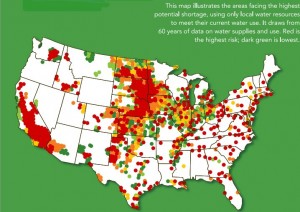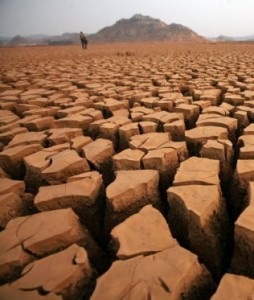Water, Water Everywhere? Maybe Not for Long
May 28th, 2013 | By admin | Category: Water IssuesBy Suzanne York, www.howmany.org
Another day, another warning by scientists that human beings are pushing the planet to a tipping point.
At the “Water in the Anthropocene” conference last week in Germany, 500 leading water scientists declared that water is becoming one of the most serious factors that could limit human development this century, with an increasing number of people affected by a water shortage so severe that it is affecting their well-being.
Blunt warning“Humans are a key feature of the global water system, influencing prodigious quantities of water: stored in reservoirs, taken from rivers and groundwater and lost in various ways,” the scientists proclaimed. Also, “additional deterioration through pollution, now detectable on a global scale, further limits an already-stressed resource base, and negatively affects the health of aquatic life-forms and human beings.”
They go on to say that severe water shortages will affect more than half the world’s future population of nine billion people by 2050 if governments fail to collaborate on international efforts to protect and conserve life’s most vital ingredient (note: the United Nations predicts population to be between 8 to 10 billion by 2050).
Fastest growing U.S. cities
Yet the world continues urbanizing, developing and industrializing at a rapid pace. The places that should be growing slower – or not at all – are still increasing, even in the face of heat, drought, and water scarcity.
In the U.S., despite a record drought last year, people are still flocking to some of the most potentially water-stressed cities. Eight of the 15 fastest-growing large U.S. cities and towns for the year ending July 1, 2012 were in Texas, according to the U.S. Census Bureau. Drought conditions still afflict much of the state, hitting farmers and ranchers the hardest.
And just last week, it was announced that the Ogallala Aquifer suffered its second-worst drop since at least 2000 in a large section of the Texas Panhandle.
Of the 15 fastest-growing large cities and towns, all but one – New York City – were in the South or West. Also on the list is Los Angeles, where last year’s rainfall amount was six inches below average.
Water scarcity in the news – scratching the surface
A cursory search of news stories on water will on average pull up a plethora of headlines about water crises around the world. For example, here are some headlines just in the past week or so:
- Water Crisis Leaves Several Areas in Lucknow Parched
- Major U.S. Cities Are at Risk for Climate-Related Water Shortage: Report
- Drop in U.S. Underground Water Levels Has Accelerated-USGS
- Twin Cities Facing Water Scarcity
- Water Scarcity Disrupts Daily Routine of People
- All Around the US, Risks Of a Water Crisis Are Much Bigger Than People Realize

Top Ten Areas with Highest Risk of Water Scarcity [photo credit: http://www.businessinsider.com/us-drought-water-scarcity-2013-5]
Recently, the Financial Times, not exactly a bastion of environmentalism, ran a story on water shortages in China. Reporter Leslie Hook noted that eight of the country’s 28 provinces “are as parched as countries in the Middle East such as Jordan and Syria.” Exacerbating the water problem is China’s rapid urbanization – more than 300 million people are expected to move to cities between now and 2030.
The Chinese government plans to invest $291 billion in water-related infrastructure projects, yet some of this will only add to the problems. More irrigation depletes aquifers and large dams displace local populations and force more people to move to cities. The Chinese are moving ahead with big and expensive projects, such as the $41 billion South-North Water Transfer. The project would divert 44.8 billion cubic meters of water per year from the Yangtze River in southern China to the Yellow River Basin in arid northern China. It has already forced 300,000 people to relocate.
The human epoch
Many scientists believe that we have entered a new geologic epoch they term “The Anthropocene.” It is defined by humanity’s growing dominance of Earth’s environment. (watch the video “Water in the Anthropocene” which was released at the conference). One example of human impact, out of many listed in the water declaration, is “More rock and sediment is now moved by human activities such as shoreline in-filling, damming and mining than by the natural erosive forces of ice, wind and water combined.”
Undoubtedly, future generations will wonder why so many people insisted on living in water-stressed cities and regions and ignored warnings. The 500 scientists who backed this declaration stated that the majority will be “living under the handicap of severe pressure on fresh water, an absolutely essential natural resource for which there is no substitute. This handicap will be self-inflicted and is, we believe, entirely avoidable.”
Why indeed.
Suzanne York is a senior writer with the Institute for Population Studies.

